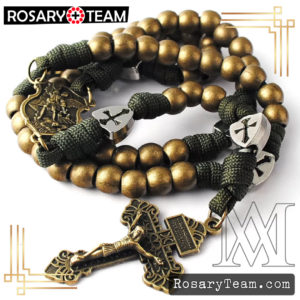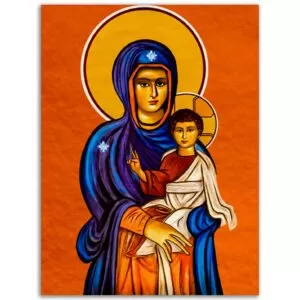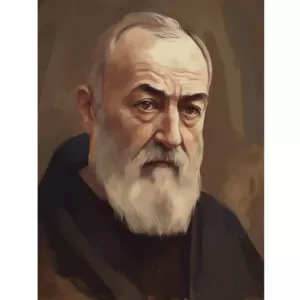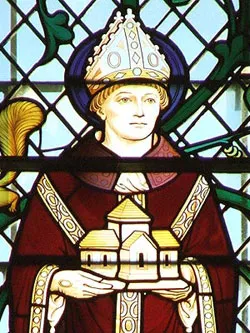SAINT PAUL, APOSTLE

SAINT PAUL, APOSTLE
Saint Paul was born into a well-to-do Jewish family of Tarsus, the son of a Roman citizen, Saul, as we shall call him until after his conversion, was sent to Jerusalem to be trained in the famous rabbinical school headed by Gamaliel.
In the year 35 Saul appears as a self-righteous young Pharisee, almost fanatically anti-Christian. He believed that the trouble-making new sect should be stamped out. We are told in Acts vii that he was present, although not a participator in the stoning, when Stephen, the first martyr, met his death. On the road to the Syrian city of Damascus, where he was going to continue his
persecutions against the Christians, he was struck blind. On arriving in Damascus the disciple Ananias cured him of his blindness and he was baptized. Paul accepted the commission to
preach the Gospel of Christ, but like many another called to a great task he felt his
unworthiness and withdrew from the world to spend three years in “Arabia” in meditation and prayer before beginning his apostolate. From the moment of his return, Paul who assumed this Roman name never paused in his labors. He himself tells us he was stoned, thrice scourged, thrice shipwrecked, endured hunger and thirst, sleepless nights, perils and hardships; besides these physical trials, he suffered many disappointments and almost constant anxieties over the weak and widely-scattered communities of Christians.
The orthodox Jews were against Paul and he had to make his escape by having himself let down
from the city wall in a basket. In Jerusalem he was there looked on with suspicion by the Jewish Christians. They could not at first believe that he who had so lately been their persecutor had turned advocate. Back in his native city of Tarsus he was joined by Barnabas and together they journeyed to Syrian Antioch where they were so successful in finding followers that a church. It was here that the disciples of Jesus were first given the name of Christians. Returning to Jerusalem to bring aid to members of the sect who were suffering from famine, these two missionaries went back to Antioch. At Antioch in Pisidia Paul delivered a memorable discourse to the Jews, concluding with these words (Acts xiii, 46-47): “It was necessary that the word of God should be spoken to you first, but since you reject it and judge yourselves unworthy of eternal life, behold, we now turn to the Gentiles. For so the Lord commanded us, I have set thee for a light to the Gentiles, to be a means of salvation to the very ends of the earth.”
The second missionary journey which lasted from 49 to 52 took Paul and Silas, his new assistant, to Phrygia and Galatia, to Troas, and across to the mainland of Europe, to Philippi in Macedonia. The physician Luke was now a member of the party and in the book of Acts he gives us the record. They made their way to Thessalonica, then down to Athens and Corinth. It was during
his first winter at Corinth that Paul wrote the earliest extant missionary letters. They show his supreme concern for conduct and his belief in the indwelling of the Holy Spirit which gives men power for good.
The third missionary journey covered the period of 52 to 56. At Ephesus where the cult of the Greek-Ionic goddess Diana was very popular. Paul raised a disturbance against the cult and the trade in silver images of the goddess which flourished there. In Jerusalem he caused a commotion by visiting the temple. He was arrested, roughly handled, and bound with chains. When he was brought before the tribune he defended himself in a way that impressed his captors. He was taken to Caesarea and was kept in prison awaiting trial for about two years.
The Roman governors, Felix and Festus, apparently wished to avoid trouble with both Jews and Christians and so postponed judgment from month to month. Paul at last appealed to the Emperor and demanded the legal right of a Roman citizen to have his case heard by Nero himself. He was placed in the custody of a centurion and was taken to Rome.
On this last visit to the various Christian communities, it is believed that he appointed Titus bishop in Crete and Timothy at Ephesus. Returning to Rome, he was once more arrested, and after two years in chains suffered martyrdom, presumably at about the same time as the Apostle Peter, bishop of the Roman Church. Inscriptions of the second and third century in the catacombs give
evidence of a cult of SS. Peter and Paul. This devotion has never diminished in popularity. In Christian art Saint Paul is usually depicted as a bald man with a black beard, rather stocky, but vigorous and intense. His relics are venerated in the basilica of Saint Paul and in the Lateran Church at Rome.
A man of action, Paul reveals the dynamic of his whole career when he writes, “I press on towards the goal, to the prize of God’s heavenly calling in Christ Jesus.” Although he himself was
forever pressing onwards, his letters often invoked a spirit of quiet meditation, as when he ends his epistle to the Philippians with the beautiful lines: “Whatever things are true, whatever honorable, whatever just, whatever holy, whatever lovable, whatever of good repute, if there be any virtue, if anything worthy of praise, think upon these things.”
rosary.team
















